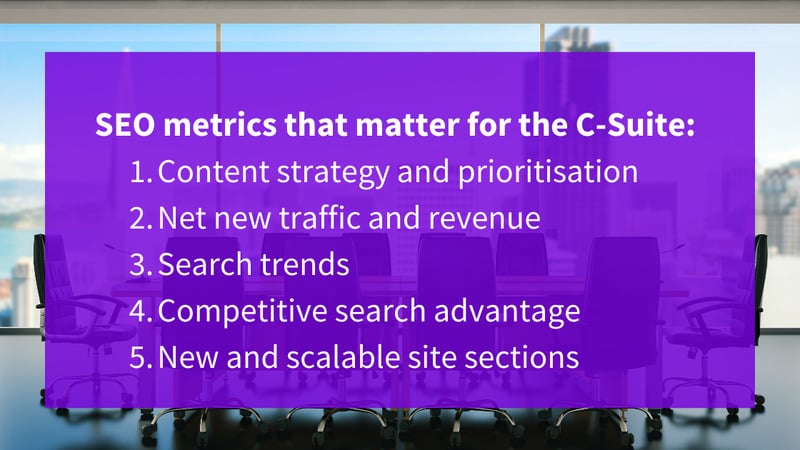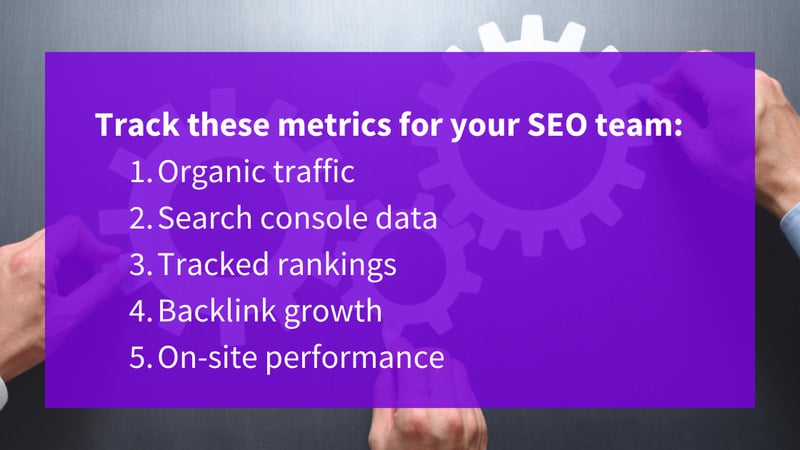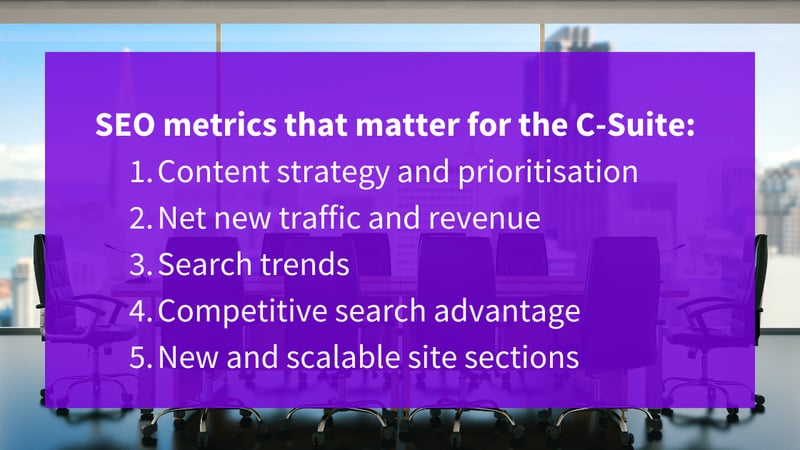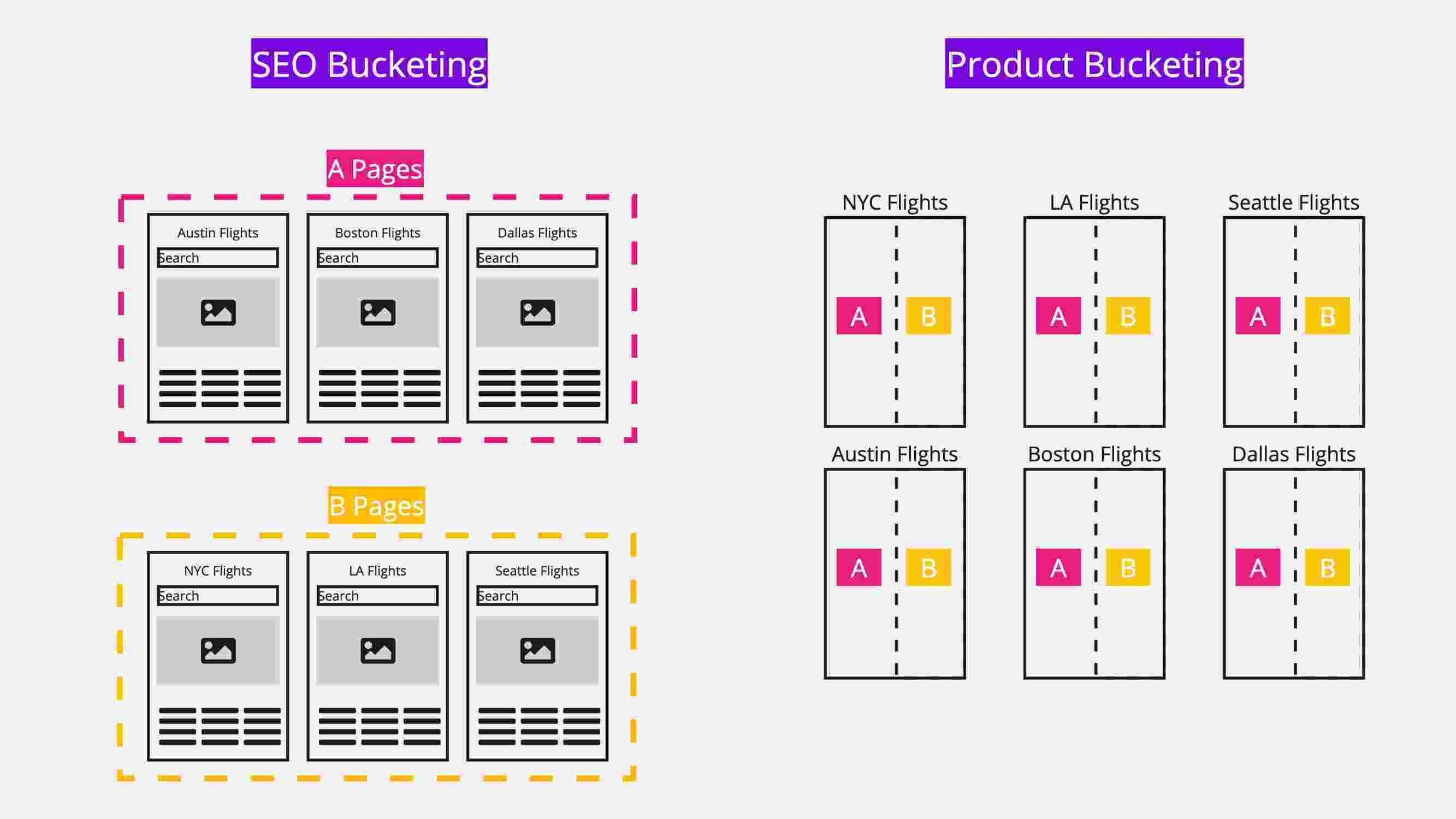As an SEO leader, you’re often looking at rich data. Some of this data is only helpful within your SEO team, but some of it is extremely relevant to the C-Suite. The right SEO information can not only drive company initiatives forward, but also shine a light on the power of SEO. In this article, we’ll share which metrics are helpful to present to the C-suite, and which are not. Let’s dive in.

What SEO information should be shared with the C-suite?
Here are a few ways that SEO metrics and research can be invaluable in the C-suite:
Net New Traffic and Revenue
As we’ll cover below, SEO teams should be optimizing their SEO split-testing cadence. As the SEO team improves their cadence, they’ll end up with more winning tests that result in new net traffic and new net revenue. These are metrics the C-suite will find invaluable (see what your C-suite needs to know about SEO tests).
Content Production
Leaders in the C-suite should remain interested in:
- How much content is being published?
- Is the content strategy being followed?
- How is the content strategy performing?
This provides high-level information and ensures the company is headed in the right direction. If not, the SEO team may need to put a new strategy in place to ensure organic growth.
Search Trend Data
SEO teams can provide helpful data on trends that allow C-suite leadership to prioritize product updates based on customer demand. If the company prioritizes the right product updates and builds the right site section around it, the company will not only validate their product ideas before building, but they’ll also capitalize on traffic growth for budding, valuable keywords. This strategy is called product-led SEO.
Competitor’s Branded Search Volume
Leaders in the C-suite will be interested in keeping track of competitor’s branded search volume. This clues them into how sophisticated the competitor’s operations are, whether they’re using the right tactics, and how your team compares.
New Scalable Site Sections
Opportunities to build scalable site sections would be a huge SEO win, but more importantly, a huge company win. The goal is to build thousands of pages at a time, not just one page at a time. This is known as Programmatic SEO. We recommend bringing ideas forward in the C-suite for new scalable site sections.
Helpful Tips for Communicating SEO Metrics in the C-suite
If you’re an SEO or marketing leader interested in using your metrics to increase budget or get more company buy-in, we recommend that you use a narrative structure.
Connect your argument to the bigger picture the company has invested in. What is leadership talking about these days? What is the CEO talking about on earnings calls? What is being discussed at the all-hands meeting? These messages are connected to what’s in the market in a broader sense.
If you can tell a compelling story around your SEO metrics and how they tie to business metrics, especially the big goals the C-suite holds for the year, then you’ll have a winning argument.
Which SEO metrics should be in your radar but not relevant for C-Suite?
This list of metrics should be closely monitored and in your radar as an SEO leader, managing your SEO team and performance. They are excellent indicators of organic health, but they’re often too granular or too tactical to be relevant for the C-suite:

Organic Traffic
Looking at organic traffic is helpful for SEO leaders, but not necessarily helpful in the C-suite because traffic needs deeper analysis to be understood. Organic traffic is often influenced by outside factors like seasonality, and may include a blend of many different types of visitors: from those performing brand searches and tangentially related searches to the key target market visitors, so on its own it’s not a great metric for depicting overall SEO health at a given moment.
If traffic is going to be looked at in the C-suite, it needs context, and analysis before being presented. We approach this through SEO split-testing, which we’ll dive into more later in the article.
Search Console Data
Search Console data includes indexation, rankings, and click-through rate. While Search Console data is sometimes helpful for you on the SEO team, it doesn’t hold a place in the C-suite.
We’ll note here that a few aspects of Search Console data are problematic even within the SEO team. For one, click-through rate is problematic due to sampling. Search Console doesn’t show all the data or even most of the data in most cases. According to Google, this is due to privacy reasons, i.e. Google is protecting the privacy of searchers who might be identifiable as individuals or as small groups.
The second way that Search Console Data is problematic even within SEO teams is due to averaging. In general, you’re seeing average click-through rates in the Search Console. And the average is taking a lot of aspects into account, such as pages where you’re in the featured snippet, ranking highly, or pages where you’re appearing in a tweet on a page. There are many different kinds of search results pages. And unless you’ve segmented it narrowly, in which case you are accentuating the sampling problem, the average click-through rate is so blended as to be unusable in many cases.
In summary, Search Console data is best kept within the SEO team itself, and even within the SEO team, needs to be used with care.
Tracked Rankings
You’re likely looking at which keywords you are ranking for and how that changes over time. This can be helpful within your team, but it’s often not helpful in the C-suite. For one, leaders in the C-suite often get a look at a subset of the keyword universe and lose sight of the bigger picture. It’s easy for leadership to get fixated on head keywords, whereas the real value is often found in long-tail keywords. For large sites it is not possible to track any significant proportion of the addressable keyword universe over time, so even the full dataset is likely to be misleading.
It’s also not helpful to present to the C-suite, for example, that you’re ranking number one for the top three keywords in your industry because this metric doesn’t help predict revenue or overall site performance. Without more context and analysis, ranking is a vanity metric. You can read more about why we don’t fixate on rankings for A/B testing here.
Backlink Growth
Of course, backlinks are incredibly important to find out if your campaigns are working. But at a higher level, it’s not immediately relevant to the business metrics that leaders in the C-suite care about, like conversions and revenue.
On-Site Performance
Is the site performance in good shape? Is the site fast? As an SEO leader, you’re likely ensuring your team is crawling the site, looking at canonical tags to make sure they’re in the right place, and examining any errors. While these are helpful metrics for your team, they don’t often play a helpful role in the C-suite because they’re too granular.
SEO Split-testing Cadence
We recommend SEO teams pay close attention to SEO split-testing cadence, also referred to as testing speed. This is a top-level goal in some of the best SEO teams I have worked with. This metric takes into consideration how many SEO tests you’re running per quarter, and more granularly:
- Are we running tests on every suitable site section?
- What are those test performances looking like?
- How many were positive?
- How many were double-digit percentage lifts?
- How many were negative?
- How many of them were neutral?
All of the above queries involved in test cadence are useful dashboard-level metrics for the SEO team to optimize.
Related Reading: Best practices for designing and running your own SEO tests
Next steps
Understanding SEO metrics within the SEO team is one thing, but communicating the important metrics to the C-suite is another.
The best way to connect your SEO metrics to the company’s bigger initiatives is to start running SEO split-tests. The data and insights you’ll gain will make for riveting conversations with leadership and real company change.
If you are ready to take a more scientific approach to SEO split-testing, request a free demo of SearchPilot.



